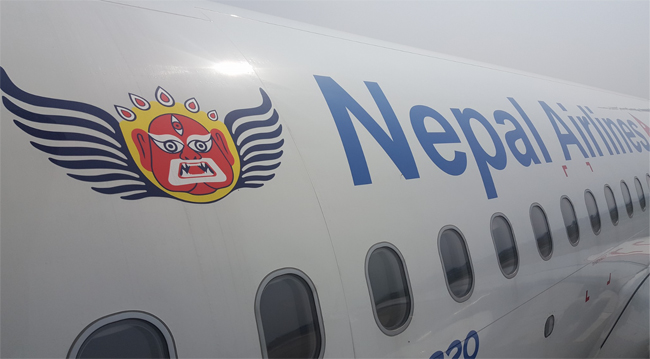The time is right for Nepal Airlines to increase capacity by adding bigger jets
Kathmandu, June 7, 2016:Â There is a mood of cautious optimism at Nepal Airlines after Finance Minister Bishnu Poudel announced in his budget speech on 28 May that the government was setting aside required money for the purchase of two new wide body aircraft.
If the state-owned airline goes ahead with the planned acquisition, possibly of Airbus 330-300 jets, the $500 million deal would be the largest ever in Nepal’s aviation history. The plane is capable of flying to Europe and Japan non-stop from Kathmandu with a capacity of up to 280 passengers.
“It is the right moment for Nepal’s national carrier to step up to the responsibility of taking care of our own nationals as well as visitors to Nepal with a larger, longer-range equipment,†says Capt Srawan Rijal who flies the airline’s new Airbus. “After one year of successful operation of our new 320s we now have the experience to upgrade to a bigger aircraft.â€
Indeed, with its new Airbus 320s Nepal Airlines increased it passenger volume by 25 per cent in 2015. Punctuality and reliability of the flights has improved dramatically. However, Nepal’s own national airline is still number five after Qatar Airways, Jet Airways, Air Arabia and Fly Dubai in terms of total passengers flown in 2015.

Industry analysts say that while the long term prospects for Nepal Airline look good, in the near future it needs to upgrade a bloated management, streamline international operations, and decide quickly on augmenting the domestic fleet.
The biggest crisis for the moment is a severe shortage of pilots for the Airbus 320s. Twice in the past month, while both Airbus 320s sat on the tarmac at Kathmandu Airport, fully-booked flights to Hong Kong and Bangkok were scrubbed because crew had reached their maximum flying hours per week.
Half of the 757 pilots who had gone for conversion training to 320s in Toulouse in the past year failed simulator tests. The airline now has only 9 captains and 13 co-pilots for 320s even though it needs at least 30 pilots for 320s alone. Airbus is providing two instructor pilots for three months to clear remaining pilots, but there will be a shortage if the 320s start crew layover routes like Doha and Kuala Lumpur.
The other quick way to induct new crew would be to entice with salaries and perks Nepali pilots flying 320s abroad. Senior captains in Nepal Airlines are paid only $1,500 per month plus allowances, whereas pilots with similar hours can earn more than $12,000 a month in an international airline.
“The only reason I stay with Nepal Airlines is because I see great growth potential and because there is nothing like flying your country’s flag,†says Capt Vijay Lama who heads international operations at Nepal Airlines. He says that with better service and reliability in the past year, Nepal Airlines has wooed back customers on its India and Hong Kong routes.
With Airbus 330s Nepal Airlines will have a captive market of 4 million Nepalis now working in Malaysia, the Gulf, Korea and Japan. It would also make the state airline able to compete with carriers that use 777s and 330s on lucrative high volume routes like Bangkok, Incheon, Hong Kong and Doha. Nepal Airlines plans to restart its Gatwick service to cater to the 100,000 Nepalis now in Britain, and also to serve as a European gateway.
The airline management are now trying to decide what to do with the two ageing 757s which were bought in 1985 and have been flying continuously since. The planes are getting costly to fly since they consume 30 per cent more fuel per passenger mile than the 320, and at present both planes are grounded because of engine and maintenance issues.
“Having Boeings and Airbuses in the same company almost makes it like we are running two airlines,†said one Nepal Airlines executive, “one is frequently cancelled, and the other is highly reliable. The two sets of crew are competing for flying hours and allowances.â€
The 757s have low resale value, and one proposal being put forward is to use them for cargo since operating cost would be much less than for passenger flights. One of the Boeings is already a Combi model with a forward cargo door. Keeping the 757s for cargo would also mean that senior Boeing captains would not lose their jobs.
One lesson from the Indian Blockade was that Nepal should look for alternatives to its dependence on Indian sea ports for trade. The air cargo sector is worth Rs 100 billion a year, and Nepal Airlines at present only has a narrow 6 per cent market share.
By Kunda Dixit







